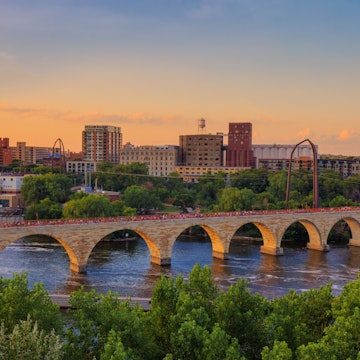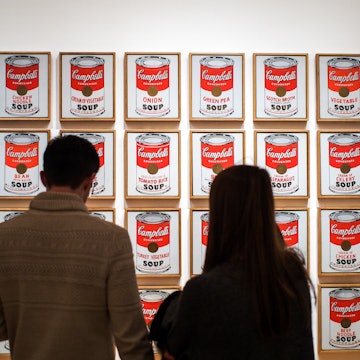

Cycling and walking are the best way to get around Minneapolis in the warmer months © CK Foto / Shutterstock
A city of starkly contrasting seasons, the best way to get around Minneapolis hinges on when you visit. Despite the month, however, the city is pretty easy to navigate thanks to its grid layout, pedestrian- and cyclist-friendly paths, a wide-spanning public transit system, and plenty of rideshare availability.
Visit in summer or fall and you’ll likely want to walk as much as possible, whereas in the dead of winter, you’ll see most folks hustling from building to building to stay warm. Here are the best ways to get around Minneapolis.
Walking
Thanks to countless parks, lakes and charming avenues, walking is just about the best way to take in Minneapolis – in the warmer months, that is. Sidewalks and pedestrian crosswalks are abundant, making it easy to pop on a good playlist and walk your way across town. Size-wise, Minneapolis is no Los Angeles, but it’s still big enough to render walking unviable when trying to cover the entire city. If you’re planning to hang out in nearby neighborhoods, heading there on foot is the way to go.
When things get icy in winter, the city’s skyways (above-ground corridors that connect buildings) are a much-needed way to stay warm when getting around downtown. Trust us, you’re going to appreciate them.

Bicycle
Minnesotans love their bikes, and the infrastructure is proof. Clocking in as the fifth most bike-friendly city in the United States in 2021, Minneapolis has a lot to brag about when it comes to accommodating cyclists. With mostly flat ground and far more bike lanes than other cities in the nation, you’d be remiss to not try it out. Rent some wheels from a Nice Ride dock station for as little as $6 per day – they can be found all throughout the city. Apart from being a practical way to get around, you can also swoop by the Mississippi River for some skyline views and breezy hangout spots.
Light Rail
The Light Rail is to Minneapolis as the subway is to New York City, though a much more petite version with considerably less of the grit. Coming onto the scene only back in 2004, this transit system connects the city to the southern suburbs and also stretches east into St. Paul. Apart from a few quick tunnels, it runs almost entirely above ground, offering some sweet views of the city.
Made up of both the Blue Line and the Green Line, the system provides easy access to the Minneapolis-St. Paul International Airport, the Mall of America, Target Field, the University of Minnesota, and both downtown Minneapolis and St. Paul – to name just a few.
You might find a higher number of passengers around rush hour, but there’s almost always a place to sit, as long as there aren’t any big events going on at the time. The Light Rail operates 24/7, and trains arrive every 10 minutes throughout the day and every 30 to 60 minutes overnight. Snag a ticket through the Metro Transit App before hopping on, or use one of the ticket vending machines available at each station.
Bus
Similar to the Light Rail, but with a far higher number of routes and destinations, the Metro Transit bus system can truly take you anywhere around the city. Though it won’t be as speedy, you’ll get where you need to go – for cheap – with more than 100 routes throughout both Minneapolis and neighboring St. Paul. The buses are clean, with air conditioning in the summer and highly necessary heat in the winter. It might take you 30 minutes for what would normally be a 15-minute drive, but express routes are available in certain parts of the city. Pay your fare with cash or by using the Metro Transit App.

Car
Renting a car is a super viable option in Minneapolis, with well-maintained roads and highways that can take you across the whole city in a matter of 10 minutes. While the city’s infrastructure encourages bike and foot traffic, that changes when the temperature plunges below freezing, leading most to huddle up in cars and public transit with the heat blasting on high.
You might encounter the famous (and lamented) Interstate 35W traffic if heading north or south around rush hour, typically between 7am and 9 am or 4pm and 6pm. Road work is a seemingly unending mission around here, frequently causing delays and congestion, much to the dismay of Minneapolis locals. The good news is, things are pretty cruisy the rest of the day.
In most neighborhoods, you’ll have no trouble finding free street parking, whereas the city’s spots are metered. Luckily, the prices aren’t too bad, and you can pay at the meter or use the handy MPLS parking app. Take heed: if you play the game of “can I park in a metered spot without paying,” you’ll lose.
Uber, Lyft and taxis
Like other US cities, you shouldn’t have any trouble hailing an Uber or Lyft from your phone. Taxis aren’t as high volume nowadays, but you can still call a Yellow Cab, though they typically aren’t roaming the streets waiting for passengers like they do in larger cities. A standard cab might be a more economical option if the rideshare apps are in price surge; otherwise, fares are generally similar.

Accessible transportation in Minneapolis
Minneapolis prides itself on being an accessible destination, so travelers with access needs are well accounted for. The city created a pedestrian ramping program for streets long before the Americans with Disabilities Act (ADA) came about, along with ensuring accessibility for parks, the riverfront, skyways and many of the must-see attractions. A brief glance through the Minnesota Travel Guide for Persons with Disabilities provides information on hotels, dining, attractions and more in great detail.
All Light Rail trains have step-free boarding, and each car has designated sections for travelers who are using wheelchairs. Station platforms are accessible via ramp. Buses are equipped with ramps and drivers who are trained to assist passengers with boarding.
Click here to download Lonely Planet's free Accessible Travel guide.
You might also like:
Best neighborhoods in Minneapolis
Top 8 parks to escape the bustle in Minneapolis
The 15 best things to do in Minneapolis that don't cost a cent















